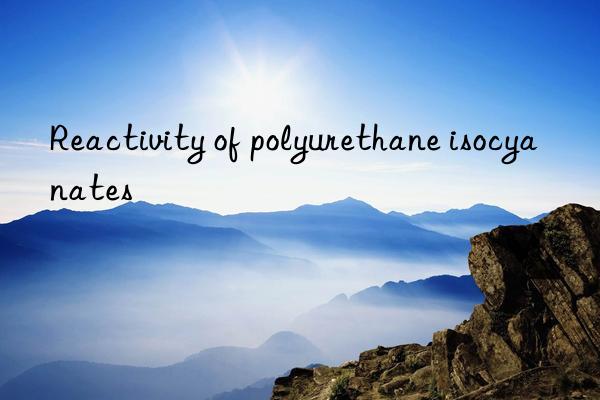
1. Reaction mechanism of polyurethane isocyanate
Organic isocyanate compounds contain highly unsaturated isocyanate groups (NCO, Structural formula - NC, so the chemical properties are very active.
Due to the large electron cloud density on oxygen and nitrogen atoms, their electronegativity is large, and the oxygen atom of the NCO group It has the highest electronegativity and is a nucleophilic center that can attract hydrogen atoms on compounds containing active hydrogen to generate hydroxyl groups. However, the hydroxyl groups on unsaturated carbon atoms are unstable and rearrange to form carbamates (if the reactant is alcohol) Or urea (if the reactant is an amine). The carbon atom has the lowest electron cloud density, is strongly positive, is an electrophilic center, and is susceptible to attack by nucleophiles. The reaction between isocyanate and active hydrogen compounds is due to the active hydrogen It is caused by the nucleophilic center in the compound molecule attacking the carbon atom of the NCO group.
2. The influence of isocyanate structure onNCO reactivity
(1) induction effect:
The electronegativity of the R group connected to the NCO group (i.e., the "core group" of the isocyanate compound) has a greater impact on the reactivity of isocyanate. If R is an electron-withdrawing group, which can make the electron cloud density of the C atom in the NCO group lower and provide stability similar to conjugation, making the C atom more electropositive and easier to interact with nucleophiles. (or nucleophilic center) reacts, so isocyanates containing electron-withdrawing groups are more active with active hydrogen compounds; conversely, if R is an electron-donating group, it will increase the electronegativity of the C atom in the NCO group (i.e., the C atom The electron cloud density increases), which reduces its reactivity with active hydrogen compounds.
Due to the induction effect between the twoNCO groups in the aromatic diisocyanate, the reactivity of the aromatic diisocyanate increases. Because when the first NCO group participates in the reaction, the other NCO group acts as an electron-withdrawing substituent. This induction effect is particularly obvious for aromatic diisocyanates that can produce conjugated systems. The activity of all aromatic diisocyanates decreases as the degree of reaction increases. This is because when one NCO group of the diisocyanate reacts with a hydroxyl group to form a urethane group, the induction effect on the other NCO group decreases. Therefore the activity is reduced.
(2 )steric hindrance effect:
The reactivity of 2,4-TDI is several times higher than that of 2,6-TDI. This is because the 4-position NCO in 2,4-TDI is far away from the 2-position NCO and -CH3 , almost no steric hindrance, while the NCO of 2,6-TDI is greatly affected by the steric hindrance effect of ortho-CH3, and the reactivity is affected.
The twoNCO groups of diisocyanate generally have different activities. For example, the 4-position NCO of 2,4-TDI is much more reactive than the 2-position. The two NCOs of 2,6-TDI are in symmetrical positions and have the same initial reactivity. However, when one of the NCOs participates in the reaction to generate a carbamate group, the induction effect is lost and the steric hindrance effect dominates, so the remaining The activity of an NCO group is greatly reduced. Table 2-2 is a comparison of the relative reactivity of the two NCO groups of the three diisocyanates TDI, XDI and HDI. They have similar situations, which is especially obvious for aromatic TDI.
The two NCO groups of MDI are far apart and have no substituents around them, so these twoEach NCO has a greater activity. Even if one NCO participates in the reaction, the activity of the remaining NCO is still greater. Therefore, the reactivity of MDI polyurethane prepolymer is greater than that of TDI prepolymer.
3. Relative reactivity of different active hydrogens and isocyanates
Due to The isocyanate group is highly reactive and can react with many substances containing active hydrogen. Active hydrogen compounds that can react with isocyanates include alcohol, water, amines (ammonia), alcoholamines, phenols, thiols, carboxylic acids, urea, etc.
It can be seen from the nucleophilic reaction mechanism that in the molecules of active hydrogen compounds, the greater the density of the electron cloud in the nucleophilic center, the stronger its electronegativity, which is similar to isocyanate. The higher the reaction activity, the faster the reaction rate; otherwise, the activity is low. That is, the reactivity of active hydrogen compounds (ROH or RNH2) is related to the properties of R. When R is an electron-withdrawing substituent (low electronegativity), the transfer of hydrogen atoms is difficult, and the reaction between active hydrogen compounds and NCO is relatively slow. Difficult; if R is an electron-donating substituent, the reactivity of active hydrogen compounds and NCO can be improved. The order of reactivity of several active hydrogen compounds with isocyanate can be arranged as follows: Aliphatic amino>Aromatic amino>primary hydroxyl>water>secondary hydroxyl >Phenolic hydroxyl>Carboxyl>Substituted urea>amide>Carbamate
Aliphatic amines react very quickly with isocyanates, followed by aromatic primary amines, which can react faster at room temperature Speed participates in the reaction. The ability of the active hydrogen group of some compounds to lose protons is weak and needs to be heated to react with isocyanatereaction.
Research has shown that phenyl isocyanate and active hydrogen-containing compounds are reacted in dioxane at 80°C at a molar ratio of 1: 1, and the measured relative reaction rates are: : Butyl phenylcarbamate 1, butyroanilide 16, butyric acid 26, diphenyl urea 80, water 98, butanol 460. It can be seen that the reaction of isocyanate with primary hydroxyl groups is much faster than that with water, aromatic urea, etc.

 微信扫一扫打赏
微信扫一扫打赏

